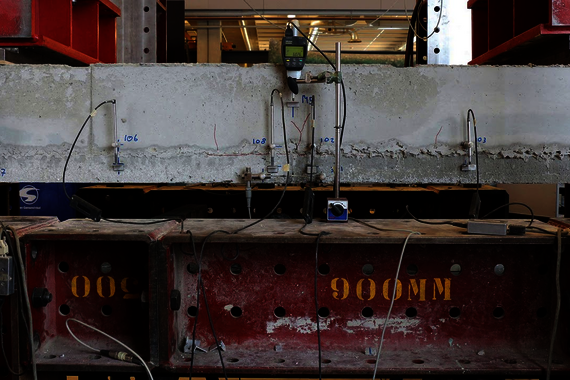![[Translate to English:] Simon Wijte in het lab van Bouwkunde bij een onderzochte proefplaat. Foto | Han Konings](/fileadmin/_processed_/9/0/csm_21_wijte___scheur_9655226a47.jpg)
- Research
- 22/05/2019
Research report on wide slab floors will stir up dust
Two years ago, part of the parking garage of Eindhoven Airport collapsed while it was still under construction. No one was injured, but the shock was enormous. The Ministry of the Interior commissioned Simon Wijte, part-time full professor at the department of the Built Environment and board member at consultancy agency Hageman, and TNO to conduct a thorough investigation into the construction defect in wide slab floors. The results of their research, which took place at the lab of Wijte’s department, was presented to the House of Representatives today, and Wijte expects that it will have far-reaching consequences: “We recommend to carry out phased inspections of every utility building built after 1999 in which this construction was used."
On the evening of Saturday, the 27th of May, a large part of the parking garage of Eindhoven Airport, which was still under construction, collapsed within a few seconds. The moment of the accident was a small blessing, because no one was injured. Part-time full professor Simon Wijte points that out once again during our meeting in Vertigo and adds: “After completion, there would have been a McDonalds under the garage, which probably would have been packed on a Saturday evening.” A frightful scenario, but as a man of science Wijte has to admit it presented him with an extremely interesting research subject. During the last two years the loading of wide slab floors has been extensively tested in the lab of the Department of the Built Environment.
Four months after the accident, Hageman and TNO (the Netherlands Organisation for applied scientific research) both presented a preliminary research report, independent of each other. The cause of the accident can be traced back to the wide slab floors that were used in the construction of the garage. Because the slab floor, which is prefabricated in the factory with self-compacting concrete, is not roughened, the concrete topping that is poured on later is unable to adhere sufficiently. Wijte: “After the floor is finished, the transfer of pulling forces from one reinforced slab floor to the other takes place via couplers that are embedded in the topping on the slab floors. But the connecting surface between the slab floor and the concrete that is poured on on the spot is not strong enough because it did not adhere sufficiently, which leads to a crack in the connecting surface along the couplers.”
The load during the moment of collapse, Wijte says, was caused by the building’s own weight: approximately 9 kilonewtons (kN) per square meter. “The extra load from cars would have been 1.5 kN per square meter. The construction was designed is such a way that it should be able to carry approximately three times its own weight. That’s a serious margin. But because of the detail error in this construction, the floor collapsed under its own weight.”
The text continues below the photo.
Calculating rules
The conclusions in the report that will be presented to the House of Representatives today will stir up some dust, Wijte believes. “We recommend to carry out phased inspections of every utility building built after 1999 in which this construction was used. The government will impose a duty to investigate, which the municipal Building Control Departments will have to uphold. We have drawn up the calculating rules to determine the safety of wide slab floors, and these rules can also be found in this report.” The duty to investigate concerns high-risk buildings, known as CC3 buildings.
Wijte can’t say exactly how many buildings will need to be inspected. “No inventory has been made, but it shouldn’t be difficult for municipalities to find out which buildings fall into this category. Luckily, we are talking about a group of ‘young’ buildings, about which there is hopefully still enough information available, even though not every owner keeps the information about their buildings. That is actually very strange, because when you buy a new car, don’t you also keep the instruction manual that comes with it? Loading tests or destructive research may need to be carried out in case the information about the concrete construction is lost.”
The report also advices to carry out the inspections in phases. Wijte: “Start with the buildings where major consequences in terms of loss of human lives are to be expected in case something goes wrong. We’re talking about buildings that are higher than seventy meters, and nursing homes and hospitals, where people are less mobile. Then you can start to think about schools and office buildings.” In conclusion Wijte emphasizes that there is no immediate danger, “but there are building regulations and rules. It is the government’s task to lay down and uphold these rules, and it is the responsibility of the owners to comply with them.”


Discussion